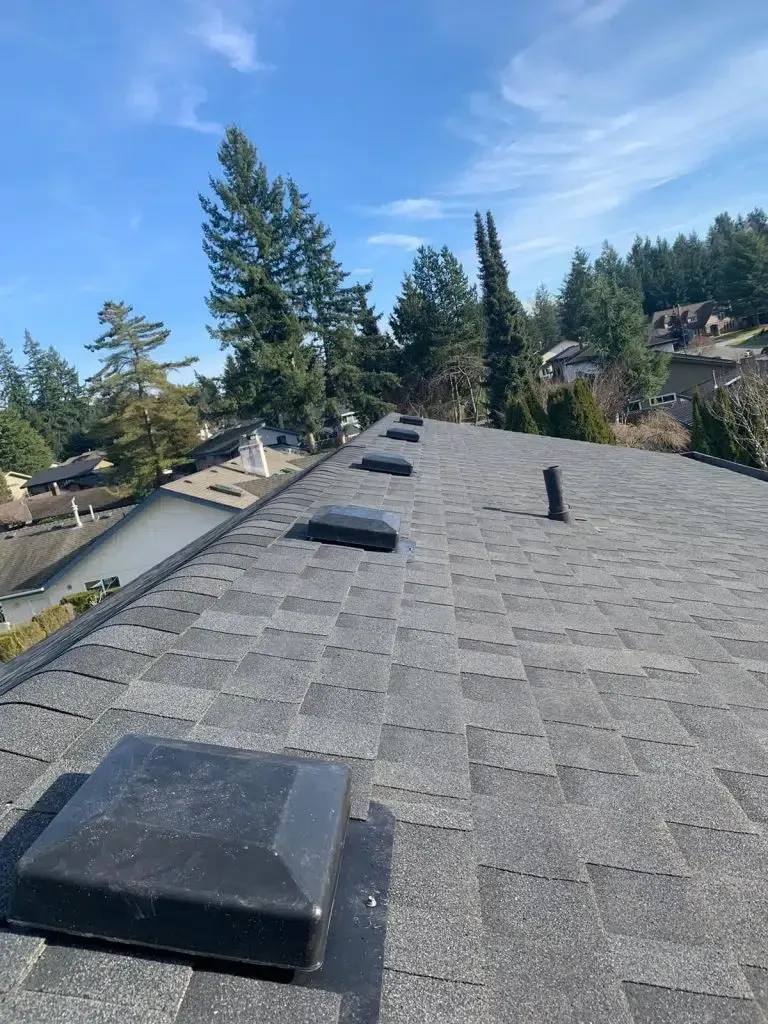SPRING ROOF TIPS FOR VANCOUVER AND SURROUNDING CITIES: A COMPREHENSIVE GUIDE FROM HARMAN AT PARAGON ROOFING BC
HOW WINTER LEAVES ITS MARK ON YOUR ROOF
Let’s be honest: our winters around vancouver , Surrey, Delta, and the rest of the Lower Mainland can be a mixed bag. Sometimes it’s a grey drizzle that never quite ends, other times we get that sudden snowfall that shuts everything down, even if it’s just a few centimetres. Regardless of what form it took this year, the winter season likely had an impact on your roof.
Snowfall, continuous rain, and even that occasional hail can lead to damage that often goes unnoticed if you don’t take a close look. Moisture can seep into small cracks, freeze, expand, and make these cracks bigger when the temperature drops. Then come the spring rains, testing all those weak spots. We’re known for rainy days around here, and the transition from winter to spring is especially crucial for catching issues before they escalate.
Below are insights gathered over my years in roofing. Each season I see the same patterns, especially in neighbourhoods spread from Vancouver to the outskirts like Langley or White Rock. With a little bit of extra attention, you can keep your roof in great condition so it weathers the next rainy winter—no pun intended—without fuss.
TIP 1: THE FIRST VISUAL INSPECTION
- Walk around the outside: Take a moment to stroll around your home and look at the overall roofline. If you see any sagging areas, it’s a sign the roof might be weakened.
- Check from the inside too: Peek into your attic or upper crawlspaces with a flashlight. Look for any beams of light poking through, or signs of water stains, mould, or mildew.
- Focus on drainage patterns: Watch how water is running off your roof during a light rain. If certain spots are dripping more heavily, it might indicate a clogged or damaged gutter area.
By simply stepping back and observing, you can catch some of the glaring red flags. A lot of folks skip this step, but I’ve seen countless minor issues turn into bigger headaches because they weren’t identified early.
GETTING GUTTERS AND DOWNSPOUTS READY FOR SPRING SHOWERS
When the maple leaves start falling in the fall—especially if you live near those beautiful big trees in areas like North Vancouver or Burnaby—your gutters inevitably pile up with leaves, twigs, and whatever else might land there. Over winter, ice can form, compounding the blockage. Now, spring rains are knocking on the door, and if your gutters aren’t clear, you’ll get water overflowing in directions it shouldn’t. That can lead to leaks and structural damage, which nobody wants.
TIP 2: CLEAR OUT DEBRIS
- Safety first: If you’re using a ladder, make sure it’s on stable ground. It’s also a good idea to have someone around for an extra pair of hands or just to keep an eye out.
- Scoop and flush: Remove leaves, twigs, and any other gunk with a scoop or a gloved hand. Then flush the gutter with a garden hose to ensure proper water flow. Watch where the water drains; any backups may indicate a hidden clog deeper in the downspout.
- Look for standing water: If water isn’t flowing freely, your gutter might have a low spot or improper pitch. Adjusting its slope can make all the difference.
Gutters can be surprisingly finicky. Even a slight misalignment can cause rainwater to pool or cascade over the side instead of flowing down the spout. It’s a simple fix once you know, but easily missed if you don’t look closely.
KEEPING AN EYE ON MOSS AND ALGAE
In our damp Lower Mainland climate, moss and algae can be common—and they’re not always just an aesthetic issue. Moss holds onto moisture like a sponge, which can accelerate the deterioration of roofing materials over time. Algae, meanwhile, can leave dark streaks and patches. While these organisms might look harmless or even “natural,” they can reduce your roof’s lifespan if left unchecked.
TIP 3: SAFE REMOVAL OF GROWTH
- Manual removal for dense moss: You can gently brush off thicker patches using a soft-bristle brush. Be mindful not to scrub too aggressively, as that can damage shingles.
- Low-pressure cleaning: For widespread growth, consider a low-pressure wash. High-pressure systems might strip away the protective granules on asphalt shingles.
- Chemical treatments: Moss and algae treatments exist that help to kill existing growth and slow future regrowth. Make sure to select an eco-friendly product when possible, especially given how important our local waterways are.
WHY MOSS THRIVES
- Shaded areas: If parts of your roof never see direct sunlight, you’ll likely have a higher risk of moss buildup.
- Frequent moisture: Our region’s famous rain provides consistent moisture, which moss loves.
- Leaves and debris: When organic material like leaves accumulate, it gives moss a lovely little habitat.
Staying vigilant about moss ensures your roof performs optimally. Some folks think a bit of greenery up there looks nice, but trust me, it does more harm than good in the long run.
SHINGLE CHECK: SPOTS, LOOSE PIECES, AND MORE
Asphalt shingles are common around Metro Vancouver—they’re versatile, relatively affordable, and can handle our weather pretty well. Still, spring is the time to make sure they’ve come through winter without issues. You don’t have to climb up there with a microscope; a pair of binoculars from the ground can often work wonders.
TIP 4: WHAT TO LOOK FOR
- Curling or buckling: If shingles look like they’re curling at the edges, it might mean they’ve taken on moisture or are simply nearing the end of their life.
- Missing granules: The top layer of an asphalt shingle has granules that protect it from UV rays and impacts. If they’re sparse or gone, the shingle’s lifespan is cut short. Check your gutters for excess granules.
- Cracked or missing shingles: Strong winter winds can tear shingles off, especially if they were already compromised. Even one missing shingle in a vulnerable spot can open the door to water damage.
If your roof is made of tile, metal, or cedar shingles, the same principle applies: keep an eye on each piece’s integrity. A quick fix in spring can save you the bigger headache of water intrusion later on.
FLASHING AND SEALS AROUND VENTS, CHIMNEYS, AND SKYLIGHTS
Flashing is that thin metal installed around roof joints, vents, chimneys, and skylights to keep water from sneaking through the gaps. In regions like ours, where we see a fair bit of rain, having properly sealed flashing is crucial. Over winter, freeze-thaw cycles can loosen flashing or degrade the sealant.
TIP 5: FLASHPROOF YOUR HOME
- Check for rust: Metal flashing can rust over time if not maintained. A rust spot here or there might be manageable with a rust converter or rust-inhibiting paint, but extensive corrosion could require replacement.
- Examine sealants: Look for cracked or dried-out sealants around edges. Caulking around vents or chimneys can degrade under UV rays and cold snaps. Replacing old or cracked sealant helps keep water out.
- Tightness counts: Sometimes flashing comes loose if the nails or screws aren’t holding tight. Give them a gentle check to make sure everything is secure.
Your flashing is the unsung hero of your roof, protecting the places where water is most likely to find a way in. A bit of care goes a long way in keeping your roof healthy.
PROTECTING YOUR ATTIC: VENTILATION AND INSULATION MATTER
Even though it’s spring, the attic can still get stuffy if ventilation isn’t up to par. Proper airflow in your attic helps regulate temperature and reduces moisture buildup. Over the winter, with heaters running and humidity in the air, some of that moisture can migrate up into the attic if it’s not well-ventilated. Then, when spring arrives with its own brand of moisture, you might see mould or mildew taking root if the problem isn’t addressed.
TIP 6: WHY VENTILATION AND INSULATION GO HAND IN HAND
- Attic vents: Soffit, ridge, and gable vents work together to circulate fresh air in and out. Check if they’re clear of debris—sometimes birds decide they want to build a little nest there come spring.
- Insulation: While the main role of insulation is to keep warm air in during colder months, it also helps keep things balanced. If insulation is damp or compressed, it won’t do its job. Watch for any signs of wet patches or mildew.
- Energy efficiency: Good ventilation and insulation can help with overall energy costs by stabilizing the temperature inside your home. It’s not just a comfort thing; it can also help prevent roof ice dams in winter.
I remember being called to a home in Delta where the homeowner had water stains on the ceiling even though there was no evident roof leak. Turned out the attic ventilation was blocked, causing condensation to build up. Sometimes the simplest issues can cause big drama.
HANDLING THOSE PESKY LEAKS BEFORE THEY GET BIG
Spring is prime time for hidden leaks to reveal themselves. You might notice a random water spot on the ceiling, or maybe a drip near a light fixture after a heavy rain. These leaks often start small, so if you see any sign at all, it’s best to investigate quickly. Delaying can lead to soggy insulation, mould growth, and even structural damage if water infiltrates repeatedly.
TIP 7: HUNTING DOWN THE SOURCE
- Start at the stain: If you see a stain on your ceiling, look directly above that area in the attic. Try to trace the trail of moisture to the roof deck. It’s not always a straight line, since water can travel along rafters or edges.
- Check vent pipes and chimneys: Vents and chimneys are common leak culprits because they penetrate the roof surface. A cracked seal or loose flashing is often all it takes.
- Small cracks, big problems: Sometimes the tiniest crack in a shingle or seam lets water in. It might only show up during heavy rain or at a certain angle. Persistence is key here.
Leaks don’t fix themselves; they only grow. Spring is the perfect window to do some detective work and nip them in the bud.
MAINTAINING A CEDAR SHAKE ROOF (IF YOU HAVE ONE)
Some older or more rustic homes around the Vancouver area still sport cedar shakes or shingles. Cedar is beautiful, and it handles moisture pretty well if properly maintained. But if you let moss or debris accumulate, or if you ignore cracked or split shingles, that roof won’t last as long as it could.
TIP 8: SPECIAL CARE FOR WOOD
- Remove debris and moss: Cedar shakes need to breathe. If leaves, pine needles, or moss collect, the wood stays damp, which leads to rot. A gentle brushing and low-pressure rinse can help.
- Oil or sealant application: Periodically, cedar shakes benefit from protective treatments that can restore their natural oils. This helps repel moisture and can extend their life.
- Inspect for cracked shakes: Wood can split over time, especially with rapid temperature changes. Replacing individual shakes promptly stops water infiltration.
Cedar has that classic West Coast look, and with the right upkeep, it can last for decades. It just demands a bit more hands-on TLC compared to some modern roofing materials.
TACKLING FLAT ROOFS: SPRING CARE AND CAUTIONS
Flat roofs are popular for some modern homes, commercial spaces, or even additions like covered patios. They often have a slight pitch for drainage, but debris can still gather in puddles if not maintained. In our climate, that standing water can quickly lead to leaks, especially around seams and drains.
TIP 9: SPECIFIC FLAT ROOF STEPS
- Check for ponding: Look for pools of water after a rainfall. This can indicate low spots or clogged drains.
- Membrane inspection: Whether it’s a torch-on membrane or a synthetic covering, watch for cracks, blisters, or lifted seams.
- Edge maintenance: Where the roof edges meet any parapet walls or flashing, make sure everything is sealed. Water can creep through small gaps.
Spring is a great season for flat-roof owners to double-check that everything drains properly before heavier rains come back or before the random hail that can sometimes pelt us.
SPRING CLEANING FOR SOLAR PANELS AND SKYLIGHTS
These days, plenty of homeowners around the Lower Mainland have installed skylights for extra natural light or solar panels for eco-friendly energy. Both are fantastic features, but they do require some routine maintenance—especially after winter’s dirt, debris, and moss.
TIP 10: GRIME-BUSTING FOR A CLEAR VIEW
- Skylights: Give them a gentle cleaning from inside and out if possible. Dirt, algae, or sap from nearby trees can build up, blocking light and sometimes affecting the seal around the frame.
- Solar panels: Dust, leaves, and grime can reduce efficiency. A simple rinse with a garden hose and a soft brush can improve their performance. Be mindful never to scrub too hard or use abrasive cleaners.
Taking a few minutes on a bright spring day to clean these features will ensure you’re getting the most out of them, especially when we actually get sunshine. Yes, it does happen in Vancouver!
CONSIDERING ROOF AGE AND REPLACEMENT
Even a well-built and well-maintained roof has a finite lifespan. Asphalt shingles, for instance, can last 20 to 25 years, while metal roofs might go 40 years or more if you’re lucky. If your roof is hitting that end-of-life range, or if you’re spending more and more on repairs, it might be worth planning for a replacement.
TIP 11: WHEN IS IT TIME?
- Frequent leaks: If you’re calling a roofer every few months, it’s probably a sign your roof has run its course.
- Worn appearance: Shingles losing granules, curling edges, or bald spots may indicate they’re at the end of their lifespan.
- Energy bill spikes: Sometimes older roofs with degraded insulation or ventilation lead to higher heating or cooling costs.
Replacement is a big project, but it can also be an opportunity to upgrade materials or boost energy efficiency. Spring is often a good time to think about it, since the weather is milder and you can plan ahead before next winter.
ECO-FRIENDLY ROOFING OPTIONS IN THE LOWER MAINLAND
Living in a place as naturally stunning as the Lower Mainland inspires many of us to choose greener home solutions. Roofing is no exception. From recycled content shingles to metal roofs that last longer, there are more choices now than ever for environmentally conscious homeowners.
TIP 12: MAKE GREEN DECISIONS
- Recycled shingles: Some manufacturers offer shingles made from recycled plastic, rubber, or wood fibre. They tend to be durable and can look quite similar to traditional asphalt.
- Metal roofing: Metal can be recycled when it finally does wear out, and its longevity means fewer replacements over time.
- Cool roofs: Light-coloured or reflective roofs help reduce heat absorption, which can lower cooling costs in the summer.
You don’t have to be an environmental activist to appreciate options that help preserve our local environment and might save you some money on energy bills in the long run. It’s a win-win.
COMMON SPRING ROOF MISTAKES TO AVOID
Even well-intentioned folks can make a few mistakes when tackling spring roof maintenance. I’ve seen plenty of minor “oops” moments that quickly add up. So here are a few pitfalls I suggest avoiding:
- Using pressure washers at full blast: This can strip away protective layers from asphalt shingles. Opt for a gentler cleaning method.
- Ignoring tiny cracks: “Oh, it’s just a hairline crack.” Over time, that hairline can become a wide-open door for water.
- Forgetting the attic: Out of sight, out of mind can lead to big moisture problems. Regular attic checks pay off.
- Overlooking ventilation: You might fix roofing materials, but if the airflow underneath is poor, problems can resurface.
- Procrastinating: Our weather can flip from sunny to stormy faster than you can say “Stanley Park.” Jump on issues early.
Learning from these common pitfalls can save both money and stress.
LOCAL HUMOUR AND WEATHER ODDITIES
If you’ve lived here long enough, you know how a day in Metro Vancouver can go: morning might be bright and sunny, so you plan a backyard gathering, only for it to rain cats and dogs in the afternoon—then it clears up again for a pink sunset. We blame the mountains, the ocean, the microclimates… we just embrace it all. One minute you’re sipping a latte at a café in Kitsilano under clear skies, and the next you’re driving through a torrential downpour on Highway 1.
When it comes to roofing, this means we’ve got to be prepared for shifts in temperature, sudden wind gusts, and an extra dose of precipitation. I can’t count how many times I’ve started a roof inspection in light drizzle, only to end up in full-blown sideways rain. Embrace the unpredictability, but don’t ignore what it can do to your roof.
SAFETY REMINDERS FOR DIY FOLKS
A lot of homeowners enjoy taking on small projects themselves, and a spring roof check might be on that list. While I applaud the do-it-yourself spirit, be mindful of safety measures:
- Ladder stability: Always place it on even ground, and consider using ladder stabilizers.
- Proper footwear: Rubber-soled shoes help with traction, especially on damp surfaces.
- Watch the weather: Don’t go up on the roof if it’s wet or windy. Slippery shingles are no joke.
- Harnesses and tie-offs: If your roof is steep or higher up, a safety harness can literally be a lifesaver.
If something feels beyond your comfort level, there’s no shame in calling a professional. The idea is to keep safe while preserving your roof’s integrity.
SPRING MAINTENANCE CHECKLIST (QUICK REFERENCE)
Here’s a concise rundown you can bookmark or jot down to keep track of all the things to do this season:
- Scan roof for damaged or missing shingles.
- Clean and inspect gutters and downspouts.
- Remove moss, algae, or any green growth.
- Check attic for signs of moisture, mould, or poor ventilation.
- Inspect flashing around chimneys, vents, and skylights.
- Ensure ridge caps and roof edges are intact.
- Look for any obvious leaks or water stains inside.
- Clear debris from flat roof drains (if applicable).
- Clean skylights and solar panels for maximum efficiency.
- Evaluate if roof age warrants a replacement plan.
Following a simple checklist can keep you organized, make maintenance feel less overwhelming, and ensure that nothing falls through the cracks. Literally.
A PERSONAL NOTE ON SPRING ROOF CARE
I’ve been up on roofs all across Vancouver, from classic heritage homes in Strathcona to modern builds in Surrey’s newer developments. Every spring, the most common sentiment I hear is, “I had no idea my roof needed that!” or “I wish I caught this problem earlier.” People are often surprised at how a little oversight can snowball.
Please, don’t wait until you see a drip in your living room during that first spring downpour. With just a bit of time and a careful approach, you can identify potential problems before they become serious. My aim is always to help folks keep their roofs healthy and secure, because your roof does more than keep you dry—it protects your entire home, family, and possessions.
DEALING WITH UNIQUE LOWER MAINLAND CHALLENGES
- Salty air near the coast: If you’re in coastal areas like White Rock or parts of Richmond, salt air can hasten corrosion of metal components.
- Snow accumulation in higher elevations: If you live around the North Shore mountains or parts of Coquitlam, you might get a bit more snow than central Vancouver. Make sure your roof can handle that extra weight and subsequent melt.
- Rain, rain, and more rain: Double-check gutters and downspouts to ensure rain flows away from your foundation.
Being aware of these local nuances can help you tailor your roof maintenance plan. Every neighbourhood can have its microclimate, especially around mountain slopes or near the water.
EXTENDING YOUR ROOF’S LIFESPAN WITH ROUTINE CARE
Routine care isn’t just about plugging leaks. It’s about adding years to your roof’s life. Think of it like changing the oil in your car. Neglect it, and you’re looking at some expensive engine repairs later. But if you stay on top of it, you’ll cruise along smoothly for a lot longer.
- Seasonal check-ups: A quick inspection every spring and fall can catch issues early.
- Regular cleaning: Removing debris prevents water buildup and moss growth.
- Ventilation upgrades: A well-ventilated attic helps your roof stay in shape.
- Quality repairs: When you do need fixes, use proper materials that match your existing roof. Cheap or mismatched patches can create more problems.
JUST A FRIENDLY WRAP-UP THOUGHT
In a place as gorgeous and sometimes quirky as Vancouver and the surrounding cities, a sturdy, well-maintained roof is a real gift. Spring offers the perfect excuse to roll up your sleeves, ensure everything is in order, and address minor issues before they bloom into something major.
There’s nothing quite like the peace of mind that comes from knowing your home is protected, especially when that spring rain decides to make a cameo at the worst possible time. With the tips outlined here, I hope you feel confident about caring for your roof, no matter what the clouds have in store.
And hey—if you’re ever up on your roof, taking in the local view, keep an eye out for those scenic mountains or maybe the neighbours who installed that fancy skylight that sparkles in the sun. We share a truly special corner of the world. Let’s make sure our roofs are just as resilient as the local spirit that we all love so much.
Stay dry, stay safe, and enjoy the sunshine when it shows up. After all, it’s Vancouver: you never really know what the weather’s going to do next. Cheers, and happy spring maintenance!




